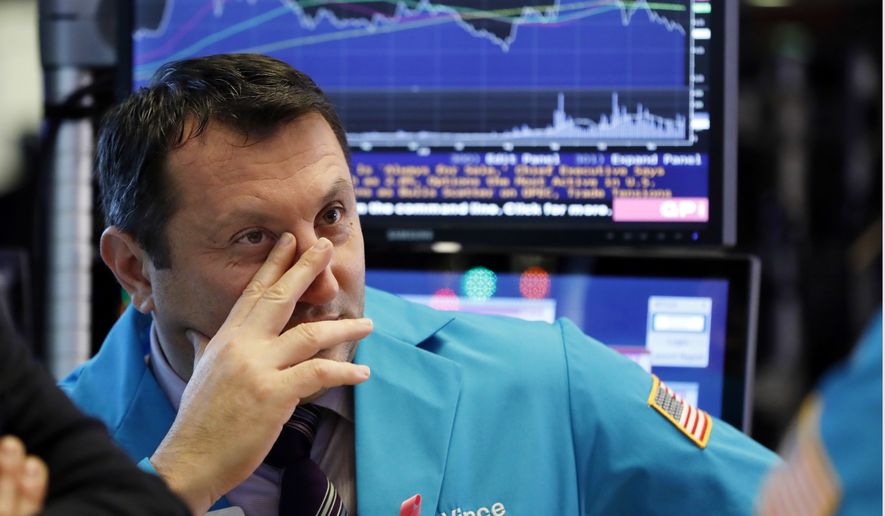Stocks recovered in a late rally Thursday after nearly wiping out all gains for the year, capping a tumultuous trading day that reflected investors’ persistent jitters over the U.S. trade war with China and fears of a weakening global economy.
The Dow Jones Industrial Average fell more than 1,500 points in two days before paring Thursday’s losses to 79 points, or 0.32 percent, to close at 24,948. The S&P 500 was down 0.15 percent, while the tech-heavy Nasdaq finished the day up 29.83 points, or 0.42 percent.
Analysts blamed a combination of worries over President Trump’s trade war with China, low oil prices, concerns about the British parliament’s ability to approve a Brexit deal and the arrest of a Chinese high-tech executive wanted by the U.S.
The president thought he had eased the concerns about tariffs last weekend, when he reached a handshake deal with Chinese President Xi Jinping for a 90-day pause in the trade war to implement specific agreements on certain exports such as oil and agricultural products.
But investors’ worries appeared to accelerate Thursday, even after Beijing belatedly gave an upbeat confirmation of the unwritten agreement with the U.S.
The arrest of Meng Wanzhou, chief financial officer of the Chinese telecom giant Huawei, reinforced concerns about the difficulties of the U.S. and China reaching a comprehensive trade deal. Mr. Trump has accused China of stealing cutting-edge technology from the U.S.
“You have got the news overnight of the arrest of the CFO of Huawei that I think is throwing a real monkey wrench into the positive optimism that surrounded the weekend meeting,” said Katie Nixon, chief investment officer for the wealth management division of Northern Trust in Chicago.
On Thursday, China’s government said it would promptly carry out the tariff cease-fire with Washington. It also expressed confidence that the two nations can reach a trade agreement. The remarks suggest Beijing wants to avoid disruptions from Ms. Meng’s arrest.
Even so, investors remained skeptical.
Meanwhile, OPEC wrapped up a meeting in Vienna without agreeing on a solution to falling oil prices. Some analysts said the oil market situation, coming on top of Mr. Trump’s threats this week to impose higher tariffs on Chinese exports if a deal falls through, is creating more uncertainty for investors.
“After President Trump’s ’Tariff Man’ tweet, markets were already questioning the progress on the tariff battle with China — or lack thereof — as evidenced by Tuesday’s rout,” Randy Frederick, vice president of trading and derivatives at Schwab Center for Financial Research, told The Washington Times. “I think the arrest of the Huawei CFO in Canada has thrown more fuel on the fire.”
Combined with Brexit worries and other factors, he said, “you have a recipe for more downside.”
At one point during Thursday’s trading session, all three of the major U.S. stock indexes were down more than 3 percent, putting each back in the red for the year.
Losses might have been pared by a Wall Street Journal report less than an hour before the closing bell that suggested the Federal Reserve could adopt a wait-and-see approach on future interest rate increases. That was relief to investors worried that the Fed might raise interest rates too fast, which could choke off economic growth.
“The Fed is trying to, in essence, come out and make it clear they are not on a rigid schedule of rate hikes next year,” said Quincy Krosby, chief market strategist at Prudential Financial.
Still, the temporary erasing of most of the market’s gains in 2018 comes after one of the best years on record. In 2017, the Dow rose 25 percent, the S&P 500 climbed 19 percent and the tech-heavy Nasdaq jumped 28 percent.
“The markets are in disarray while the economy remains in good shape,” said Joel Naroff, president of Naroff Economic Advisors Inc. in Holland, Pennsylvania. “To the extent that the uncertain messages being sent about the status of trade negotiations with China are creating fear, there is every good reason to mark down values. That is especially true if you believe, as I do, that values were probably too high to begin with.”
Aside from trade, concerns over bond yields and interest rates have pressured the stock market in recent days.
Traders continued to shovel money into bonds, a signal that they see weakness in the economy ahead. The yield on the 10-year Treasury note fell to 2.89 percent from 2.92 percent on Thursday, a big move, as traders scaled back expectations on the number of rate hikes the Fed would implement amid weakening economic data and market volatility.
“The market seems right now to be focused on increased risks for a 2020 recession,” said Patrick Schaffer, global investment specialist at JPMorgan Private Bank. “It’s a very hard market to buy when you see really strong signals that we are indeed late [in the economic] cycle.”
• This article is based in part on wire-service reports.
• Dave Boyer can be reached at dboyer@washingtontimes.com.
• S.A. Miller can be reached at smiller@washingtontimes.com.




Please read our comment policy before commenting.